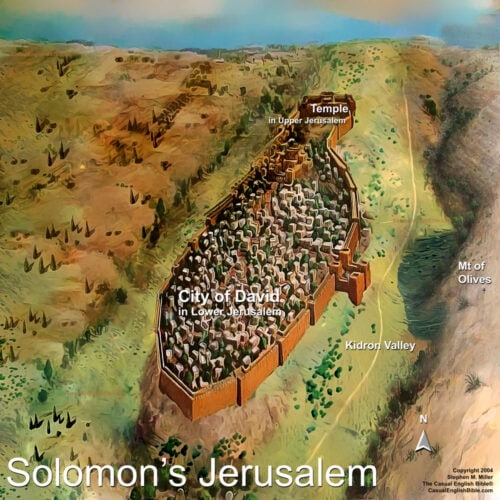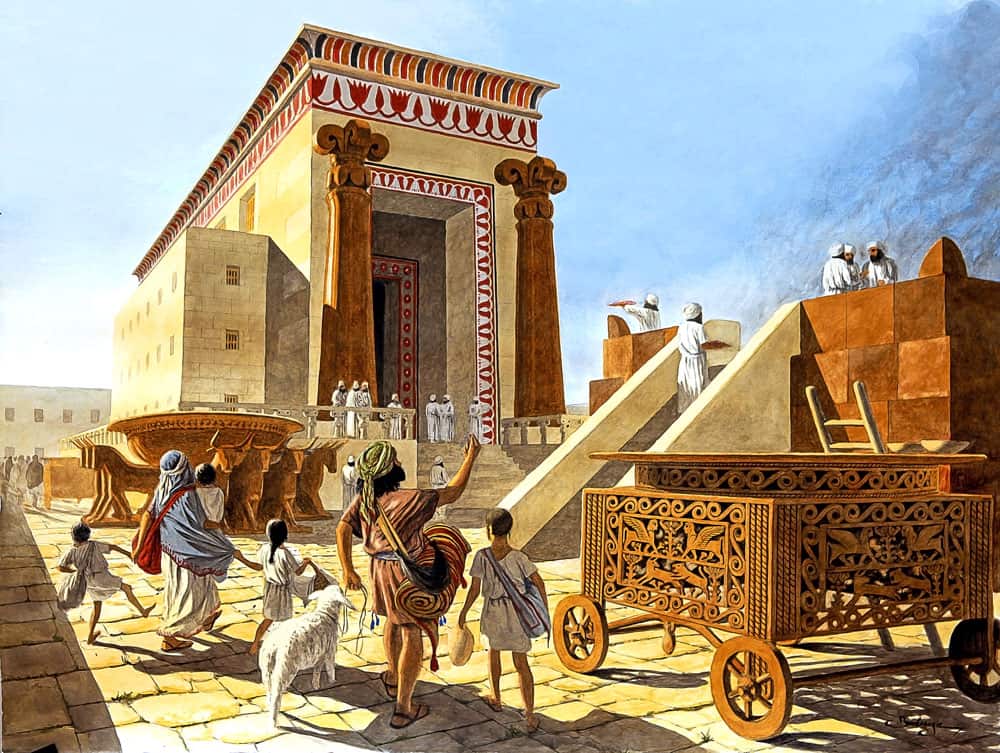2 Chronicles 4
Master artisan helps build Jerusalem Temple
Temple under construction
1 Kings 7:23-51 1Huram-abi, a master craftsman on loan to Solomon from King Hiram in Tyre, built a huge sacrificial altar overlaid in bronze. It stretched 30 feet long and wide and rose 15 feet high. [1]
2Then he made a massive bronze bowl 15 feet across. It was more than seven feet deep and 45 feet around the rim’s circumference. They called this bowl the Sea. [2] 3He decorated the entire outside rim with two rows of bull images, six bulls per foot, [3] cast into the bronze. 4 He mounted the bowl on the backs of 12 bronze bulls—three facing outwards in each direction, north, south, east, and west.
5The bronze of the bowl was as thick as a man’s hand is wide, about three inches. [4] The brim looked like an open lily, with the rim curving outward. It held 11,000 gallons. [5] 6He made 10 water basins for washing and for rinsing the meat they would burn as offerings for God. Priests, however, washed in the huge basin, the Sea. Gold lamplight inside the Temple
7He made 10 golden lampstands to hold the olive oil lamps that would light the inside of the Temple. They put five on each side of the main room, the Holy Place. 8He made 10 tables, as well, placing five on opposite sides of the main room. He made 100 small bowls, too. All 100 of them were gold. At work outside the Temple
9Outside the main Temple building, he constructed a courtyard for the priests, and another courtyard beyond that. He built doors separating the two and overlaid them with bronze. 10He placed the huge Sea basin at the southeast corner of the Temple.
11Huram-abi, the master artisan from Tyre, made utensils for the priests: pots, shovels, and small bowls. He did his work for King Solomon and helped finish the Temple of God. Artisan’s to-do list
12Huram-abi built these for the Temple:
- Twin pillars at the entrance
- Two huge pillars
- Two bowl-shaped capitals on top of the pillars
- Two designs, one for each column: the look of chains woven into nets
13Four hundred pomegranates hanging below the capitals, in two rows
14Ten mobile water reservoirs mounted in carts
15The large reservoir called the Sea, mounted on a dozen bronze bulls
16All the bronze utensils for the Temple, including meat forks along with pans and shovels to collect ashes of the sacrificed animals.
Huram-abi made all of this from polished bronze, at King Solomon’s instruction.
17Huram-abi cast all this bronze work in molds made from the Jordan River Valley clay found between the towns of Succoth and Zarethan. [6]
18Solomon didn’t bother to document the weight of all this bronze. There was too much to weigh.
19In addition to ordering bronze work for the Temple, Solomon ordered all the other furnishings used inside:
Golden altar
Golden table for sacred bread representing God’s presence with Israel
20Golden lampstands with lamps, for light inside the Temple.
21Flower arrangements
Gold lamps
Gold tongs for holding hot coals
22Small golden bowls
Golden lamp snuffers to put out the lamplight
Golden firepans as incense burners
Doors, overlaid with gold, leading into the main sanctuary and into the Most Holy Place.
Footnotes
14:1That’s 9 by 9 by 4.5 meters.
24:2Over two meters deep, 4.5 meters across, and 13.25 meters in circumference. This bowl was the Temple’s water tank, a reservoir that held 11,000 gallons (about 40,000 liters). That’s a little more than half the water in the typical swimming pool. Much of the water was probably used for cleaning up after a sacrifice.
34:3Or about 20 bulls per meter.
44:5About 75 millimeters.
54:5About 40,000 liters.
64:17These neighboring towns are about 30 miles (47 km) north of Jerusalem, a day and a half walk. They are on opposite sides of the river, with Succoth east, near a popular river crossing at Adam, now Damia Bridge.
Videos
1Huram-abi, a master craftsman on loan to Solomon from King Hiram in Tyre, built a huge sacrificial altar overlaid in bronze. It stretched 30 feet long and wide and rose 15 feet high. [1]
2Then he made a massive bronze bowl 15 feet across. It was more than seven feet deep and 45 feet around the rim’s circumference. They called this bowl the Sea. [2] 3He decorated the entire outside rim with two rows of bull images, six bulls per foot, [3] cast into the bronze. 4 He mounted the bowl on the backs of 12 bronze bulls—three facing outwards in each direction, north, south, east, and west.
5The bronze of the bowl was as thick as a man’s hand is wide, about three inches. [4] The brim looked like an open lily, with the rim curving outward. It held 11,000 gallons. [5] 6He made 10 water basins for washing and for rinsing the meat they would burn as offerings for God. Priests, however, washed in the huge basin, the Sea.
11Huram-abi, the master artisan from Tyre, made utensils for the priests: pots, shovels, and small bowls. He did his work for King Solomon and helped finish the Temple of God.
14Ten mobile water reservoirs mounted in carts
15The large reservoir called the Sea, mounted on a dozen bronze bulls
16All the bronze utensils for the Temple, including meat forks along with pans and shovels to collect ashes of the sacrificed animals.
Huram-abi made all of this from polished bronze, at King Solomon’s instruction. 17Huram-abi cast all this bronze work in molds made from the Jordan River Valley clay found between the towns of Succoth and Zarethan. [6]
18Solomon didn’t bother to document the weight of all this bronze. There was too much to weigh.
19In addition to ordering bronze work for the Temple, Solomon ordered all the other furnishings used inside:
Golden altar
Golden table for sacred bread representing God’s presence with Israel
20Golden lampstands with lamps, for light inside the Temple.
21Flower arrangements
Gold lamps
Gold tongs for holding hot coals
22Small golden bowls
Golden lamp snuffers to put out the lamplight
Golden firepans as incense burners
Doors, overlaid with gold, leading into the main sanctuary and into the Most Holy Place.
2Then he made a massive bronze bowl 15 feet across. It was more than seven feet deep and 45 feet around the rim’s circumference. They called this bowl the Sea. [2] 3He decorated the entire outside rim with two rows of bull images, six bulls per foot, [3] cast into the bronze. 4 He mounted the bowl on the backs of 12 bronze bulls—three facing outwards in each direction, north, south, east, and west.
5The bronze of the bowl was as thick as a man’s hand is wide, about three inches. [4] The brim looked like an open lily, with the rim curving outward. It held 11,000 gallons. [5] 6He made 10 water basins for washing and for rinsing the meat they would burn as offerings for God. Priests, however, washed in the huge basin, the Sea.
Gold lamplight inside the Temple
7He made 10 golden lampstands to hold the olive oil lamps that would light the inside of the Temple. They put five on each side of the main room, the Holy Place. 8He made 10 tables, as well, placing five on opposite sides of the main room. He made 100 small bowls, too. All 100 of them were gold.At work outside the Temple
9Outside the main Temple building, he constructed a courtyard for the priests, and another courtyard beyond that. He built doors separating the two and overlaid them with bronze. 10He placed the huge Sea basin at the southeast corner of the Temple.11Huram-abi, the master artisan from Tyre, made utensils for the priests: pots, shovels, and small bowls. He did his work for King Solomon and helped finish the Temple of God.
Artisan’s to-do list
12Huram-abi built these for the Temple:- Twin pillars at the entrance
- Two huge pillars
- Two bowl-shaped capitals on top of the pillars
- Two designs, one for each column: the look of chains woven into nets
14Ten mobile water reservoirs mounted in carts
15The large reservoir called the Sea, mounted on a dozen bronze bulls
16All the bronze utensils for the Temple, including meat forks along with pans and shovels to collect ashes of the sacrificed animals.
Huram-abi made all of this from polished bronze, at King Solomon’s instruction. 17Huram-abi cast all this bronze work in molds made from the Jordan River Valley clay found between the towns of Succoth and Zarethan. [6]
18Solomon didn’t bother to document the weight of all this bronze. There was too much to weigh.
19In addition to ordering bronze work for the Temple, Solomon ordered all the other furnishings used inside:
21Flower arrangements
Footnotes
14:1
That’s 9 by 9 by 4.5 meters.
24:2
Over two meters deep, 4.5 meters across, and 13.25 meters in circumference. This bowl was the Temple’s water tank, a reservoir that held 11,000 gallons (about 40,000 liters). That’s a little more than half the water in the typical swimming pool. Much of the water was probably used for cleaning up after a sacrifice.
34:3
Or about 20 bulls per meter.
44:5
About 75 millimeters.
54:5
About 40,000 liters.
64:17
These neighboring towns are about 30 miles (47 km) north of Jerusalem, a day and a half walk. They are on opposite sides of the river, with Succoth east, near a popular river crossing at Adam, now Damia Bridge.






